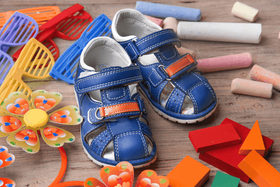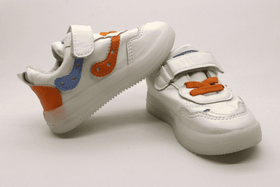8 Effective Exercises to Strengthen Your Child's Feet and Ankles
A comprehensive guide to strengthening your child's feet and ankles, featuring 8 effective exercises that promote stability, mobility, and injury prevention.
Updated August 19, 2024.

Is your child having trouble keeping up with their friends at school, feeling clumsy, or even hurting their ankle? These problems can be caused by weak feet and ankles.
It's sad to see your child feel bad because of weak feet. These problems can make it hard for them to play sports, dance, or even just have fun. The good news is that there's something you can do. By making your child's feet and ankles stronger, you can help them feel better and do more.
» Support your kid: Build up their feet and ankles with orthopaedic shoes
Why Should Your Kid Do Foot and Ankle Exercises?
Strong feet and ankles are essential for your kid to stay balanced and move quickly. [1] Their feet are the base that supports their whole body, whether they're sitting still or running around. They act like shock absorbers, protecting their body from the impact of walking, running, and jumping.
When your kid's feet are weak, it can cause problems in their knees, hips, and even your back. They also help them feel more confident and perform better. They can even help prevent injuries and falls.
» Learn the signs your kid sprained their ankle
Our 8 Best Foot Rehab Exercises
1. Toe Splay
Steps:
- Have your kid sit or stand comfortably with their feet flat on the floor. You can make it more challenging by using a dome or balance ball, engaging their ankle muscles for a stability boost.
- The toes should be spread as wide apart as possible like they're trying to push the ground away with each toe.
- Your kid should hold for 5 seconds, feeling the stretch and engagement in their foot.
- After 5 seconds, they can relax their toes and squeeze them back together.
- Repeat 10-15 times.
Benefits:
Strengthens the intrinsic muscles of the foot. They support the arches, preventing bunions and hammertoes.
Improves stability and balance, leading to fewer stumbles and falls.
Enhances proprioception. Stronger toe muscles improve coordination and agility.
» Find out what to look for in orthopaedic shoes for children
2. Toe curls
Steps:
- Have your little one stand with their feet flat on the floor.
- They should curl their toes inwards as much as they can, imagining they're gripping the ground with them.
- Then, they should hold the position for 5 seconds. To make it extra challenging, you can have them lift their entire heel off the ground while keeping their toes curled. This engages their calf muscles and toes.
- After the repetition, they can relax their toes to straighten them out completely.
- Encourage them to repeat the exercise 10-15 times.
Benefits:
Strengthens the flexor muscles of the toes, which help grip surfaces. The result is better balance and push-off during walking and running.
Maintains the natural arch of your kid's foot, preventing pain and discomfort.
Improves sensory awareness and coordination in the feet.
» Learn to address your kid's pigeon toes
3. Marble pickup
Steps:
- Scatter a handful of marbles on the floor. The smaller the marbles, the more complex the exercise.
- Have your kid sit comfortably with their feet flat on the ground.
- Using only their toes, they should pick up each and transfer them to a bowl or container.
- Encourage your kid to repeat the action 10–15 times for each foot.
Benefits:
Refines the fine motor skills of your kid's toes and feet, enhancing their ability to grip and manipulate objects.
Engages the tiny muscles responsible for arch support and stability, preventing bunions and hammertoes.
Improves their spatial awareness and coordination.
» Understand the difference between regular and supportive kid's shoes
4. Sand Walking
Steps:
- Find a soft, sandy area on the beach.
- Have your kid walk barefoot for a few minutes.
- Pay attention to their posture, keeping their back straight and core engaged.
- Gradually increase the distance and intensity of their walks as their strength and comfort improve.
Benefits:
Improves overall leg strength and stability due to uneven terrain.
Boosts their awareness and foot placement because of the shifting sand.
Promotes relaxation and stimulates nerve endings.
» Explore the myths and facts about toddler shoes
5. Heel Raises
Steps:
- Have your kid stand with their feet shoulder-width apart.
- They should slowly raise their heels off the ground as high as they can, squeezing their calf muscles.
- After that, they should hold the position for 2–3 seconds before lowering it back down.
- Encourage them to repeat the action 10–15 times.
Benefits:
Strengthens calf muscles and Achilles tendon. Your child will have better push-off power for walking, running, and jumping.
Improves balance and ankle stability. Stronger calves contribute to better balance and reduce the risk of ankle sprains.
Corrects posture and reduces strain on your kid's lower back.
» Learn more about the waddling gait in children
6. Toe Walking
Steps:
- Your kid should stand flat on their feet with a shoulder-width apart.
- Have them lift their heels off the ground, balancing on their toes. They should keep their core engaged and back straight.
- They should stroll for a short distance, maintaining their balance.
- To start, your little one should do 10–15 steps and gradually increase them as they get more comfortable.
Benefits:
Strengthens intrinsic foot muscles
Enhances balance and coordination
Increases ankle mobility
» Identify the early signs of foot drop in your kid
7. Ankle Circles
Steps:
- Have your kid stand tall with their feet hip-width apart.
- They should slowly rotate their ankles in small circles, 10x clockwise and 10x counterclockwise.
- Gradually increase the size of the circles as they get comfortable.
- Encourage them to repeat the action for 2–3 sets in each direction.
Benefits:
Improves ankle mobility and range of motion, boosting balance and movement control.
Warms up your ankles to prevent injuries.
» Discover the effects of improperly sized shoes on kids
8. Heel Walking
Steps:
- Have your little one stand tall with their feet shoulder-width apart.
- They should keep their toes pointed up and walk on their heels for a short distance.
- Focus on engaging their calf muscles with each step.
- Start with 10–15 steps and gradually increase as they get comfortable.
Benefits:
Strengthens calf muscles to improve push-off power for walking, running, and jumping.
Challenges your balance and coordination, leading to better stability and overall movement control.
Engages your calf muscles helps maintain good posture, reducing strain on your lower back.
Don't Let Weak Feet Hold Your Child Back
Strengthening your child's feet and ankles is essential for their overall stability and mobility. By incorporating these exercises into their routine, you can help them develop strong feet that will support them throughout their lives.
Remember to start slowly and gradually increase the intensity and duration of the exercises as your child's strength improves. With consistent practice, your child will be well-equipped to tackle any physical challenges.
» Strengthen your child's feet and ankles with orthopaedic shoes
References:
- T. Kalaycioglu, N. C. Apostolopoulos, Y. Yurt, and V. B. Tunay, “The effectiveness of different ankle strengthening training programs on performance,” The Journal of Sports Medicine and Physical Fitness, vol. 62, no. 4, Mar. 2022, doi: 10.23736/s0022-4707.21.12130-9. Available: https://pubmed.ncbi.nlm.nih.gov/33768775/
FAQs
How long does it take to strengthen a kid's feet?
Strengthening a child's feet can take time, but consistency is key. Regular practice of targeted exercises can yield noticeable improvements within a few weeks.
What is the most common foot problem in kids?
Flat feet are one of the most common foot problems in children. This condition occurs when the arch of the foot doesn't develop properly. While it's often harmless, it can sometimes lead to discomfort or pain.
Why does my child have weak ankles?
- Insufficient exercise can lead to underdeveloped muscles in the ankles and feet.
- Spending too much time sitting or being sedentary can weaken the muscles and ligaments in the ankles.
- Previous ankle sprains or injuries can weaken the ankle joint over time.
- Improperly fitting shoes can contribute to weak ankles by providing inadequate support.
- Certain medical conditions, such as neuromuscular disorders or bone diseases, can affect ankle strength.
How do you treat ankle pronation in children?
- Wearing supportive shoes with good arch support and cushioning can help control excessive pronation.
- Custom-made orthotics can provide additional support and correction for ankle pronation.
- Exercises prescribed by a physical therapist can help strengthen the muscles in the feet and ankles, improving stability and reducing pronation.
- Regular stretching of the calf muscles and Achilles tendon can help address tightness that may contribute to pronation.
- Maintaining a healthy weight can reduce stress on the feet and ankles, including pronation.
How do I improve my kid's walking style?
- Wearing supportive shoes with good arch support and cushioning can help control excessive pronation.
- Exercises prescribed by a physical therapist can help strengthen the muscles in the feet and ankles, improving stability and reducing pronation.
- Regular stretching of the calf muscles and Achilles tendon can help address tightness that may contribute to pronation.
- Custom-made orthotics can provide additional support and correction for ankle pronation.
- Maintaining a healthy weight can reduce stress on the feet and ankles, including pronation.
Disclaimer: First Walkers' information is intended for educational and informational purposes related to toddler footwear and feet. We encourage you to consider individual circumstances and consult qualified orthopedists about specific conditions.




